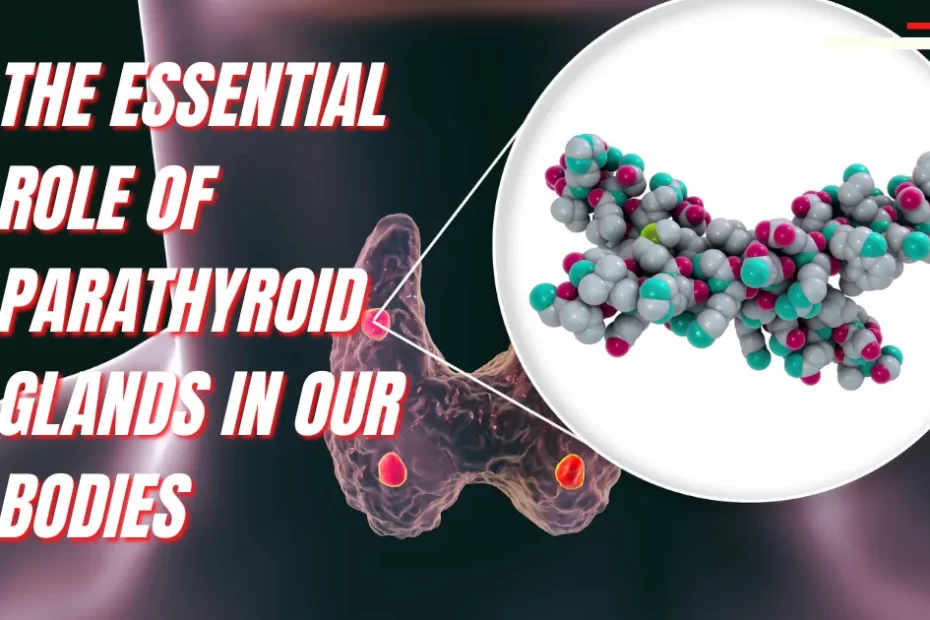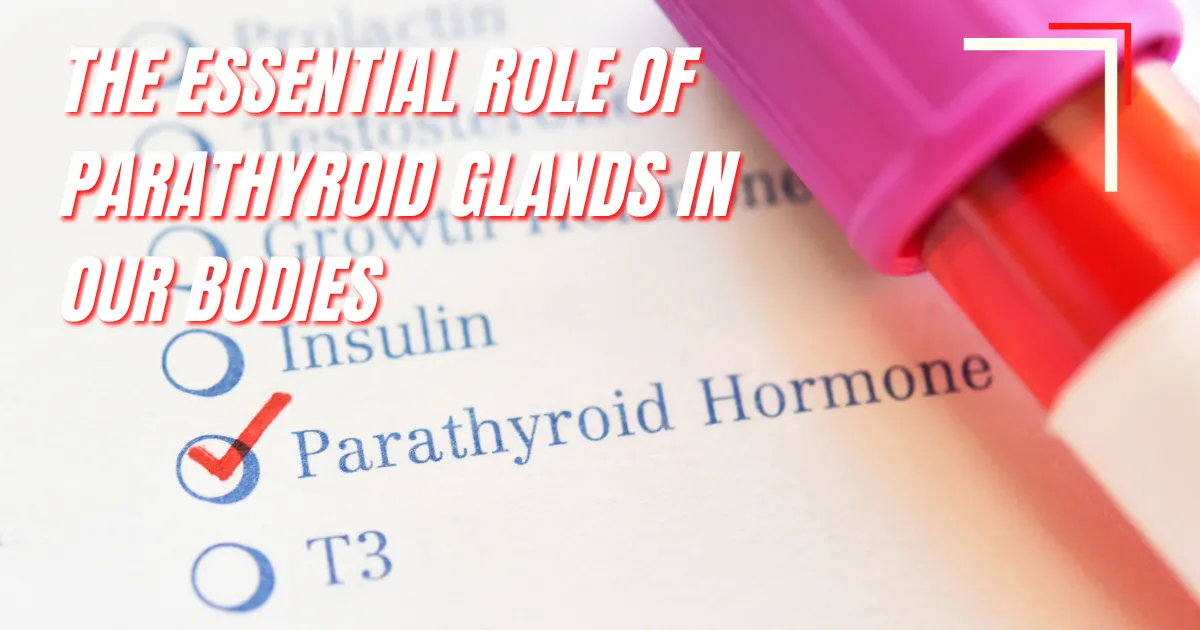Last updated on October 25th, 2023 at 09:31 am
Parathyroid Gland: The parathyroids are four small glands that lie on either side of the thyroid gland. Despite their close proximity and similar names, parathyroids have very different functions from the thyroid.
The Parathyroids produce a hormone that acts to release calcium from bones to increase the level of calcium in the blood. In contrast, the thyroid gland, among other things produces calcitonin, which is a hormone that causes bones to take up calcium and reduce the levels of it in the blood — the opposite function of the parathyroid hormone.
The parathyroid gland, also known as parathyroid, is a small endocrine gland instrumental in regulating calcium and phosphorus metabolism within the human body. Typically, an individual has four parathyroid glands, though the number may differ. These glands, located in the neck, are typically situated near or attached to the thyroid’s posterior lobe.
Parathyroid Glands and Their Key Functions
The parathyroid glands secrete the parathyroid hormone (PTH), the primary regulator of calcium levels in the blood. When blood calcium levels fall below a specific threshold, PTH is released. This hormone stimulates calcium release from bones, increases the body’s ability to absorb calcium from food, and signals the kidneys to reduce calcium excretion in urine.
Parathyroid gland diseases include hyperparathyroidism, which arises when one or more of the glands become overactive, producing excess PTH, resulting in elevated blood calcium levels. Conversely, hypoparathyroidism occurs when the glands do not produce sufficient PTH, leading to low blood calcium levels.
Treatments for these diseases range from medication to surgery, depending on the cause and severity of the condition.
Irregularities in hormone levels, primarily PTH, produced by the parathyroid glands, can lead to severe medical conditions. Here are two of the most common:
Hyperparathyroidism: This condition occurs when the parathyroid glands produce excess PTH, causing elevated blood calcium levels, also known as hypercalcemia. Symptoms range from mild to severe and can include fatigue, weakness, depression, bone or joint pain, kidney stones, appetite loss, nausea, vomiting, constipation, confusion, and in severe cases, coma or even death. Additionally, it can increase the risk of osteoporosis and bone fractures.
Hypoparathyroidism: This condition arises when the parathyroid glands do not produce sufficient PTH, resulting in low blood calcium levels, known as hypocalcemia. Symptoms can include tingling or numbness in the fingertips, feet, and around the mouth; muscle spasms; cramps; weakness; chest pain; fatigue; dry, brittle hair; fragile nails; and dry skin. Additionally, cardiac and neurological issues may arise.
Diagnosis of these conditions typically involves laboratory tests to measure blood calcium and parathyroid hormone levels. Treatment can range from calcium and vitamin D supplements to surgery, based on the cause and severity of the condition.
Understanding Parathyroid-Related Diseases
The function of the parathyroid glands is crucial to the regulation of calcium in the body, and the loss of these glands can have dire consequences. Here’s what could occur in each scenario:
Two parathyroid glands: A person can function normally with only two parathyroid glands, provided they are healthy and can produce enough PTH to maintain adequate calcium levels. Sometimes, during thyroid surgery, for example, some parathyroid glands may be accidentally or intentionally removed, but at least two are preserved to maintain normal function.
One parathyroid gland: Even with one parathyroid gland, if it is healthy, it might produce enough hormone to maintain normal blood calcium levels.
Zero parathyroid glands: The removal or loss of all parathyroid glands (a condition known as surgical hypoparathyroidism) can result in dangerously low blood calcium levels, known as hypocalcemia. Symptoms can include tingling, muscle spasms, cramps, weakness, and in severe cases, seizures or even heart failure. Individuals who have lost all their parathyroid glands will need to take calcium and vitamin D supplements for life to maintain normal blood calcium levels.
When a person has lost all their parathyroid glands, a condition known as hypoparathyroidism develops. This means their body cannot produce enough PTH, crucial for maintaining adequate calcium and phosphorus levels in the blood. In this case, patients will have to follow a lifelong treatment plan to manage their condition and prevent hypocalcemia symptoms.
Parathyroid Glands: The Unsung Heroes Of Our Well-being
Hypoparathyroidism treatment typically includes the following:
- Calcium and Vitamin D Supplements: Patients generally need to take high-dose oral calcium and vitamin D supplements to increase blood calcium levels. Vitamin D is crucial because it aids the body in absorbing calcium.
- Diet: A high-calcium, low-phosphorus diet may also be required. High-calcium foods include dairy products, dark leafy greens, and citrus fruits, among others. High-phosphorus foods to avoid or limit can include red meats, dairy products, beans, and nuts.
- PTH Replacement Therapy: In some cases, a drug that mimics the action of the parathyroid hormone can be prescribed. This medication, called teriparatide (Forteo), can help regulate blood calcium levels.
- Regular Monitoring: Treatment will require regular follow-ups with a doctor to ensure that calcium levels remain within a normal range and that calcium and vitamin D supplements are adjusted as necessary.
Phosphorus is an essential mineral for the human body, fulfilling several critical functions:
- Bone and Tooth Formation: About 85% of the body’s phosphorus is found in the bones and teeth, where it helps strengthen and form these tissues.
- Energy Production: Phosphorus is involved in the production of ATP (adenosine triphosphate), a molecule that stores and provides energy for various cellular functions.
- Cellular Function: Phosphorus is vital for the formation of DNA and RNA (the genetic building blocks of life), cell membrane function, and helps regulate enzyme and hormone activity.
- Acid-Base Balance: Phosphorus also plays a role in maintaining the body’s pH balance by helping to balance acids and bases.
- Energy Storage and Use: Phosphorus is an essential component of several molecules that store and transport energy in the body, including ATP and creatine phosphate, a molecule that helps provide energy to muscles.
Phosphorus deficiency can result in muscle weakness, brittle bones, fatigue, and other issues. However, phosphorus deficiency is rare in individuals who maintain a balanced diet, as phosphorus is found in many foods, including meats, dairy products, nuts, legumes, and whole grains. Conversely, excess phosphorus can interfere with the body’s ability to utilize other minerals such as iron, calcium, and magnesium, and in extreme cases, can damage the kidneys.
Impacto de la Disfunción Paratiroidea en la Salud Humana
La glándula paratiroides, también llamada parathyroidea, es una glándula endocrina pequeña pero esencial. Desempeña un papel crucial en la regulación del metabolismo del calcio y el fósforo en el cuerpo humano. Aunque la mayoría de las personas tienen cuatro glándulas paratiroides, este número puede variar. Se ubican en el cuello, generalmente cerca o adyacentes al lóbulo posterior de la tiroides.
Estas glándulas producen la hormona paratiroidea (PTH), la principal reguladora de los niveles de calcio en la sangre. Cuando estos niveles decaen, las glándulas paratiroides secretan PTH, que estimula la liberación de calcio de los huesos, incrementa la capacidad del cuerpo para absorber calcio de los alimentos, y solicita a los riñones que reduzcan la excreción de calcio en la orina.
Los trastornos paratiroideos incluyen hiperparatiroidismo, que surge cuando una o más de las glándulas son hiperactivas y producen exceso de PTH, lo que resulta en altos niveles de calcio en la sangre; y el hipoparatiroidismo, que ocurre cuando las glándulas no generan suficiente PTH, conduciendo a bajos niveles de calcio en la sangre.
El abordaje de estas afecciones varía desde tratamientos farmacológicos hasta cirugía, dependiendo de la causa y la gravedad del problema.
Irregularidades en los niveles de las hormonas producidas por las glándulas paratiroides, especialmente la PTH, pueden derivar en serios problemas de salud. Aquí están dos de las más comunes:
Hiperparatiroidismo: Esta condición ocurre cuando las glándulas paratiroides generan demasiada PTH, llevando a un alto nivel de calcio en la sangre, también conocido como hipercalcemia. Los síntomas pueden variar desde leves hasta severos, incluyendo fatiga, debilidad, depresión, dolor en los huesos o articulaciones, cálculos renales, pérdida de apetito, náuseas, vómitos, estreñimiento, confusión, y en casos extremos, coma o muerte. Además, puede incrementar el riesgo de osteoporosis y fracturas óseas.
Hipoparatiroidismo: Este trastorno se produce cuando las glándulas paratiroides no generan suficiente PTH, conduciendo a bajos niveles de calcio en la sangre, también conocido como hipocalcemia. Los síntomas pueden incluir hormigueo o entumecimiento en las puntas de los dedos, en los pies y alrededor de la boca; espasmos musculares; calambres; debilidad; dolor en el pecho; fatiga; cabello seco y quebradizo; uñas frágiles; y piel seca. También puede presentarse con problemas cardíacos y neurológicos.
El diagnóstico de estas afecciones implica pruebas de laboratorio para medir los niveles de calcio y PTH en la sangre. El tratamiento puede variar desde suplementos de calcio y vitamina D hasta cirugía, dependiendo de la causa y la gravedad del problema.

